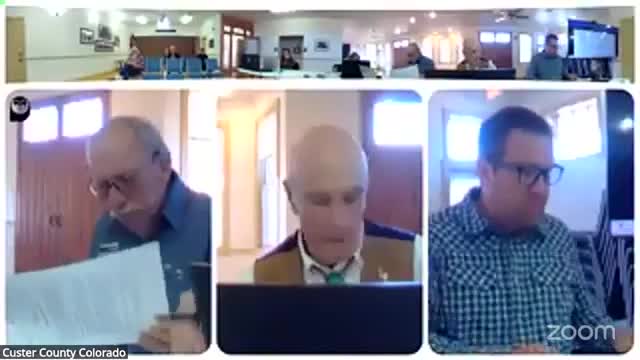Custer County approves evacuation-route study contract to model wildfire evacuations
October 22, 2025 | Custer County, Colorado
This article was created by AI summarizing key points discussed. AI makes mistakes, so for full details and context, please refer to the video of the full meeting. Please report any errors so we can fix them. Report an error »

The Custer County Board of Commissioners on Oct. 22 approved a contract for an evacuation‑route study designed to model wildfire behavior and evacuation traffic to guide planning and resource deployment.
County Chair Bill Candid and emergency staff said the study will combine dynamic fire‑behavior modeling with traffic simulation to estimate “clearance time” for evacuations and identify locations where residents, animals and special‑needs populations are most at risk.
John Van Dort, introduced by the board as the county emergency officer, told commissioners the study will analyze vegetation, topography and wind scenarios and overlay those with models of vehicle movement during evacuations. He said the modeling will allow staff and the sheriff’s office to test scenarios — for example, a fire driven by a 10 mph wind versus a 50 mph wind — and estimate how long it will take to clear particular neighborhoods or subdivisions.
"That'll tell us some really important, valuable, life‑saving information," Van Dort said, adding the study will help the sheriff plan how to deploy resources and where mutual‑aid partners should be staged. He also said the study will account for people who slow traffic during evacuations, including those towing trailers or needing medical assistance.
Commissioners and staff said the work is mostly funded through Title III (federal/state program funds referenced in the meeting) and that roughly 95% of the contract cost will come from that funding source. The contract cost was discussed in the meeting as approximately $57,000 but the board characterized the funding detail as coming primarily from Title III allocations.
The board voted to execute the contract; the motion and second were recorded and the vote passed unanimously by the three commissioners present.
Commissioners said the study will help set priorities for vegetation management (fuel reduction) across public and private lands and provide data to inform future mitigation projects and public education. Van Dort said the study results will be presented to the county and will likely prompt additional planning and mitigation steps.
The board did not set a public deadline for delivery of the final report during the meeting; staff said the contract includes follow‑up briefings for commissioners to discuss results and next steps.
The board’s approval was presented as a formal contract authorization; staff said they had negotiated changes to the draft to better suit county needs before executing the agreement.
County Chair Bill Candid and emergency staff said the study will combine dynamic fire‑behavior modeling with traffic simulation to estimate “clearance time” for evacuations and identify locations where residents, animals and special‑needs populations are most at risk.
John Van Dort, introduced by the board as the county emergency officer, told commissioners the study will analyze vegetation, topography and wind scenarios and overlay those with models of vehicle movement during evacuations. He said the modeling will allow staff and the sheriff’s office to test scenarios — for example, a fire driven by a 10 mph wind versus a 50 mph wind — and estimate how long it will take to clear particular neighborhoods or subdivisions.
"That'll tell us some really important, valuable, life‑saving information," Van Dort said, adding the study will help the sheriff plan how to deploy resources and where mutual‑aid partners should be staged. He also said the study will account for people who slow traffic during evacuations, including those towing trailers or needing medical assistance.
Commissioners and staff said the work is mostly funded through Title III (federal/state program funds referenced in the meeting) and that roughly 95% of the contract cost will come from that funding source. The contract cost was discussed in the meeting as approximately $57,000 but the board characterized the funding detail as coming primarily from Title III allocations.
The board voted to execute the contract; the motion and second were recorded and the vote passed unanimously by the three commissioners present.
Commissioners said the study will help set priorities for vegetation management (fuel reduction) across public and private lands and provide data to inform future mitigation projects and public education. Van Dort said the study results will be presented to the county and will likely prompt additional planning and mitigation steps.
The board did not set a public deadline for delivery of the final report during the meeting; staff said the contract includes follow‑up briefings for commissioners to discuss results and next steps.
The board’s approval was presented as a formal contract authorization; staff said they had negotiated changes to the draft to better suit county needs before executing the agreement.
View full meeting
This article is based on a recent meeting—watch the full video and explore the complete transcript for deeper insights into the discussion.
View full meeting
